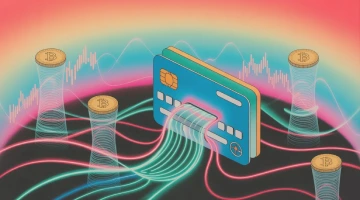Everything You Need to Know About Cross-Chain Bridges

In the ever-evolving landscape of blockchain technology, the need for interoperability and seamless communication between different blockchain networks has become increasingly apparent. Cross-chain bridge development has emerged as a vital component of the blockchain ecosystem, facilitating the exchange of assets and data between independent blockchain networks. Blockchain bridges play a pivotal role in realizing the vision of a fully interconnected and decentralized world.
The Challenge of Blockchain Isolation
Blockchain technology has seen remarkable growth and innovation over the past decade, leading to the emergence of numerous blockchain networks with unique features and use cases. However, these networks often exist in isolation. In this context, a blockchain isolation refers to the nature of individual networks, preventing them from seamlessly communicating and sharing information or assets with one another.
Blockchain isolation is a significant impediment to the broader adoption and utility of decentralized technology. Consider, for example, the challenge of moving data or crypto assets between different blockchains. If you want to transfer a cryptocurrency token from one blockchain to another or execute a smart contract across multiple networks, the current lack of interoperability can be a substantial roadblock.
The Role of Cross-Chain Bridges
Cross-chain bridges are the solution to breaking down these blockchain isolation. Blockchain bridges act as intermediaries that enable the transfer of assets or data between different blockchains. Essentially, they create a seamless connection, allowing for interoperability between otherwise isolated networks.
Wrapped Tokens Explained
Wrapped tokens are an essential part of cross-chain bridge development. Let’s explore what wrapped tokens are, how they work, and their importance in the cryptocurrency ecosystem.
The Basics of Wrapped Tokens
Wrapped tokens, often referred to as "wrapped assets" or simply "wraps," are digital representations of real-world assets or other cryptocurrencies that are issued on a blockchain, typically as ERC-20 tokens on the Ethereum network.
The primary function of wrapped tokens is to create a one-to-one correspondence between the value of the underlying asset and the digital representation on the blockchain. For example, one wrapped Bitcoin (WBTC) should always be equivalent in value to one Bitcoin (BTC) held in a traditional wallet.
How Wrapped Tokens Work
To create wrapped tokens, a custodian holds the underlying asset (e.g., Bitcoin) and issues an equivalent amount of wrapped tokens on a blockchain. Bridge smart contracts are responsible for maintaining the same amount of the underlying asset as the wrapped tokens in circulation. This ensures that there is always a 1:1 peg between the wrapped token and the asset it represents.
Smart Contract Development Role in Cross-Chain bridge:
- Locking tokens and wrapped tokens to secure the circulation supply is not changing
- Minting and Burning: Issuing new wrapped tokens when the assets are deposited and burning wrapped tokens when the assets are withdrawn.
- Transparency: Storing data on bridge transactions on Blockchain in a transparent manner
This Cross-Chain Bridge mechanism guarantees that the wrapped token can be redeemed for the underlying asset at any time, giving users the confidence that their digital representation holds real-world value.
How Cross-Chain Bridges Work?
1. Lock-Unlock basis
Cross-chain bridges that work on lock/unlock basis operate by locking assets on one blockchain and issuing corresponding assets on another blockchain, typically in a one-to-one ratio. This ensures that the value remains consistent as it moves across different chains. These bridges employ a variety of technologies, such as multi-signature wallets, smart contracts, and oracles, to facilitate secure and trustless asset transfers.
For instance, let's say you want to move a token from the Ethereum blockchain to the Binance Smart Chain (BSC). A cross-chain bridge would enable you to lock your token on Ethereum and then issue an equivalent token on the BSC. The locked asset on one chain is secured and cannot be accessed until an equivalent asset is released on the other blockchain, ensuring the integrity of the transaction.

2. Mint-Burn basis
Cross-chain bridges that operate on Mint/Burn basis operate in a similar way, but instead of locking assets on one blockchain and issuing corresponding assets on another blockchain, the tokens are minted and burned instead. This ensures that the value remains consistent as it moves across different chains. Mint/Burn bridges also utilize a variety of technologies, such as multi-signature wallets, smart contracts, and oracles, to facilitate secure and trustless asset transfers.
Alternative Cross-Chain Solutions
- Atomic Swaps
Atomic Swaps, also known as "cross-chain swaps" or "trustless swaps," are a decentralized method for exchanging cryptocurrencies directly between users of different blockchain networks without the need for intermediaries or custodians. The core idea behind Atomic Swaps is that two parties agree to trade their assets in a way that either both transactions occur, or neither does, ensuring trustless execution.
Key Features of Atomic Swaps:
- Trustless: Users maintain control of their assets throughout the swap, reducing counterparty risk.
- Security: Atomic Swaps rely on cryptographic principles to ensure that the exchange is irreversible and secure.
- Decentralization: The process does not involve third parties, making it a true peer-to-peer exchange method.
Challenges of Atomic Swaps:
- Liquidity: Atomic Swaps may suffer from liquidity limitations, especially for less common assets.
- Complexity: The technical complexity of Atomic Swaps can be a barrier to entry for some users.
2. Layer 2 (L2) Solutions
Layer 2 solutions are protocols or technologies built on top of existing blockchains, such as Ethereum, to enhance their scalability and reduce transaction fees. L2 solutions, like the Lightning Network for Bitcoin or Optimistic Rollups for Ethereum, enable faster and more cost-effective transactions by processing transactions off-chain or with minimal on-chain interaction.
Key Features of Layer 2:
- Scalability: L2 solutions can process a high volume of transactions without congesting the underlying blockchain.
- Low Fees: Transaction costs are significantly reduced, making microtransactions more feasible.
- Instant Confirmations: Users experience faster confirmation times, approaching near-instant finality.
Challenges of Layer 2:
- Integration: L2 solutions require support from the underlying blockchain, and adoption can be slow.
- Centralization Concerns: Some L2 solutions introduce centralization risks, which can be a point of contention in the blockchain community.
3. Rollups
Rollups are a layer 2 scaling solution designed to improve the performance of Ethereum and other blockchains. They work by aggregating multiple transactions into a single data layer (the rollup) and then periodically submitting this data to the Ethereum mainnet. Rollups come in two flavors: Optimistic Rollups and ZK-Rollups, each with its own approach to handling data and security.
Key Features of Rollups:
- Scalability: Rollups allow for significant throughput improvements on the Ethereum network and other blockchains.
- Data Efficiency: By compressing transactions into a single rollup, they reduce the burden on the mainnet.
- Security: ZK-Rollups, in particular, provide a high level of security through cryptographic techniques.
Challenges of Rollups:
- Development Complexity: Implementing Rollups can be technically challenging, and there are trade-offs between security and efficiency.
- Adoption: Widespread adoption of Rollup solutions is still in its early stages.
4. Sub-Chains
Sub-Chains, also known as side chains or child chains, are separate blockchains that are connected to a parent blockchain, usually the mainnet. They offer a degree of independence and flexibility while still benefiting from the security and features of the parent chain. Assets and data can be moved between the main chain and sub-chains, providing interoperability.
Key Features of Sub-Chains:
- Independence: Sub-Chains can have their consensus rules, governance, and asset management.
- Interoperability: Assets and data can be moved between the main chain and sub-chains, facilitating cross-chain communication.
- Scalability: Sub-Chains can relieve congestion on the main chain by processing transactions off-chain.
Challenges Sub-Chains:
- Security: Sub-Chains must maintain their security to prevent vulnerabilities or attacks.
- Complexity: Managing assets and data between the main chain and sub-chains can be intricate.
While cross-chain bridges have been a pioneering solution for blockchain interoperability, alternatives such as Atomic Swaps, Layer 2 solutions, Rollups, and Sub-Chains offer promising avenues for addressing the challenges of blockchain isolation and facilitating seamless interaction between different networks. The blockchain space continues to innovate and evolve, and these alternatives play a vital role in shaping the future of blockchain technology and its ability to connect disparate ecosystems.
Benefits of Cross-Chain Bridges
Cross-chain bridges development and adoption offer several significant advantages to the blockchain ecosystem:
- Interoperability: Cross-chain bridges promote interoperability, allowing different blockchains to work together seamlessly. This is crucial for realizing the full potential of blockchain technology.
- Asset Portability: Users can easily move their digital assets between different blockchain networks, opening up new possibilities for trading, yield farming, and DeFi applications.
- Risk Mitigation: Cross-chain bridges minimize the risk of centralized exchange hacks or platform failures. Users retain control of their assets throughout the cross-chain transfer process.
- Scalability: By allowing assets to move across different blockchains, cross-chain bridges can help alleviate congestion and scalability issues on popular networks like Ethereum.
- Diversity of Use Cases: With cross-chain compatibility, developers and businesses can create innovative solutions that leverage the strengths of multiple blockchains, enabling a broader range of use cases.
- Global Adoption: Cross-chain bridges facilitate broader adoption of blockchain technology by making it easier for individuals and organizations to interact with multiple blockchain networks.
Find more insights on our post: 10 Reasons Why Your Token Needs a Cross-Chain Bridge
Cross-Chain Solution Examples
Several cross-chain bridge projects have gained recognition within the blockchain community:
- Wormhole: Built on the Solana blockchain, Wormhole enables the transfer of assets between Solana and Ethereum.
- Polkadot: Polkadot is a multi-chain network designed for cross-chain interoperability, and its relay chain serves as a bridge between different parachains.
- Cosmos: The Cosmos network aims to create an "Internet of Blockchains," and the Inter-Blockchain Communication (IBC) protocol allows for interoperability between various blockchains in the Cosmos ecosystem.
- Binance Bridge: Binance, one of the world's largest cryptocurrency exchanges, offers a bridge to connect its native blockchain, Binance Smart Chain (BSC), with other popular networks like Ethereum.
- Avalanche Bridge: The Avalanche network provides a bridge that connects its ecosystem with Ethereum, enabling assets and data to move freely between the two blockchains.
Challenges and Future Development
While cross-chain bridge development is a significant step toward blockchain interoperability, they are not without challenges. Security is a paramount concern, as any vulnerabilities in bridge protocols can lead to potential exploits and asset losses. Additionally, ensuring the decentralization of bridge operators is essential for maintaining trust in the cross-chain ecosystem.
Future development in the cross-chain space will likely focus on improving security, expanding support for more blockchains, and enhancing user-friendliness. Solutions that offer seamless, decentralized, and trustless cross-chain transfers will be critical to the continued growth and adoption of blockchain technology.
In conclusion, cross-chain bridges are a fundamental component of the blockchain ecosystem, enabling interoperability and asset portability across different networks. As the blockchain industry continues to evolve, these bridges will play an increasingly vital role in connecting disparate ecosystems and unlocking the full potential of decentralized technology. With ongoing development and security enhancements, cross-chain bridges are poised to pave the way for a truly interconnected and decentralized world.
We ❤️ Development
Follow us on social media to receive the hottest blockchain development updates
Crunchbase ⚡️ Twitter ⚡️ Telegram ⚡️ LinkedIn ⚡️ Facebook ⚡️ Zupyak ⚡️ Quora ⚡️ Reddit













%201.webp)



